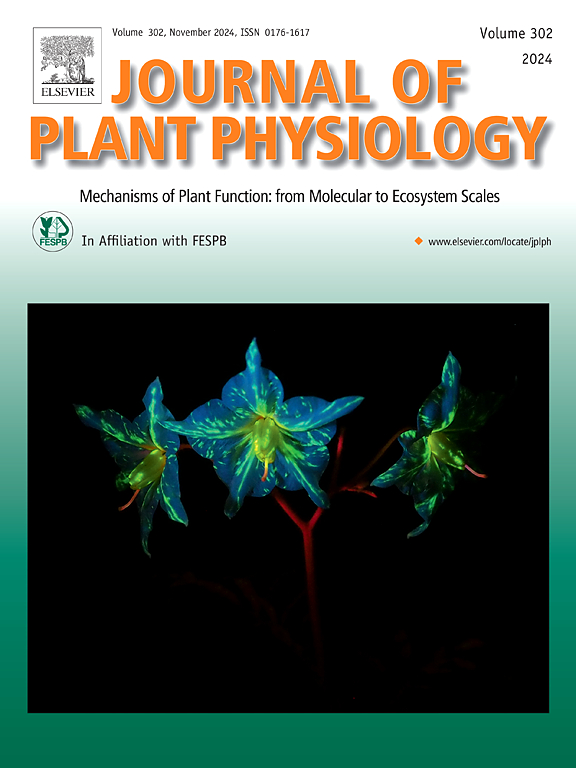菖蒲咖啡酸o -甲基转移酶的分子克隆与特性研究
IF 4.1
3区 生物学
Q1 PLANT SCIENCES
引用次数: 0
摘要
挥发性苯丙烯,包括α-和β-细辛酮,是甜菖蒲(菖蒲)特有的芳香成分,已被用作医药原料。然而,对菖蒲中挥发性苯丙烯产生的生物合成酶的研究仍然有限。本研究分析了菖蒲植物中挥发性苯丙烯,包括α-和β-细辛酮。通过rna测序分析,我们发现了一个编码s -腺苷- l-蛋氨酸依赖的o -甲基转移酶(acct)的基因,该基因通过间羟基甲基化将咖啡酸转化为阿魏酸。在大肠杆菌中表达的重组acct蛋白特异性催化咖啡酸、5-羟基阿魏酸和5-羟基松柏醇间羟基的o -甲基化。相比之下,它对儿茶酚型二苯乙烯和类黄酮(如picenotrol和槲皮素)没有可检测到的活性。此外,对α-细辛酮和β-细辛酮、6-羟基-(E)-异丁香酚和6-羟基-(Z)-异丁香酚的推定前体均无活性。系统发育分析表明,acct与其他植物物种的典型COMT蛋白具有较远的进化关系。我们的研究结果表明,与其他comt不同,acct酶在早期分化并遵循独特的进化轨迹,而不是起源于趋同进化。本文章由计算机程序翻译,如有差异,请以英文原文为准。
Molecular cloning and characterization of caffeic acid O-methyltransferase from Acorus calamus
Volatile phenylpropenes, including α- and β-asarone, are characteristic aromas of sweet flag (Acorus calamus) and have been used as ingredients in pharmaceutical applications. However, studies on the biosynthetic enzymes involved in the production of volatile phenylpropenes in A. calamus remain limited. In this study, we analyzed volatile phenylpropenes, including α- and β-asarone, in the A. calamus plants. Using RNA-sequencing analysis, we identified a gene encoding S-adenosyl-L-methionine-dependent O-methyltransferase (AcCOMT), which converts caffeic acid to ferulic acid via the methylation of the meta-hydroxy group. The recombinant AcCOMT protein expressed in Escherichia coli specifically catalyzed O-methylation of the meta-hydroxy group of caffeic acid, 5-hydroxyferulic acid, and 5-hydroxyconiferyl alcohol. In contrast, it exhibited no detectable activity toward catechol-type stilbenes and flavonoids, such as piceatannol and quercetin. Additionally, no activity was observed towards the putative precursors of α-asarone and β-asarone, 6-hydroxy-(E)-isoeugenol and 6-hydroxy-(Z)-isoeugenol, respectively. Phylogenetic analysis revealed that AcCOMT has a distant evolutionary relationship to canonical COMT proteins from other plant species. Our results suggest that AcCOMT enzymes diverged early and followed a unique evolutionary trajectory, distinct from that of other COMTs, rather than originating through convergent evolution.
求助全文
通过发布文献求助,成功后即可免费获取论文全文。
去求助
来源期刊

Journal of plant physiology
生物-植物科学
CiteScore
7.20
自引率
4.70%
发文量
196
审稿时长
32 days
期刊介绍:
The Journal of Plant Physiology is a broad-spectrum journal that welcomes high-quality submissions in all major areas of plant physiology, including plant biochemistry, functional biotechnology, computational and synthetic plant biology, growth and development, photosynthesis and respiration, transport and translocation, plant-microbe interactions, biotic and abiotic stress. Studies are welcome at all levels of integration ranging from molecules and cells to organisms and their environments and are expected to use state-of-the-art methodologies. Pure gene expression studies are not within the focus of our journal. To be considered for publication, papers must significantly contribute to the mechanistic understanding of physiological processes, and not be merely descriptive, or confirmatory of previous results. We encourage the submission of papers that explore the physiology of non-model as well as accepted model species and those that bridge basic and applied research. For instance, studies on agricultural plants that show new physiological mechanisms to improve agricultural efficiency are welcome. Studies performed under uncontrolled situations (e.g. field conditions) not providing mechanistic insight will not be considered for publication.
The Journal of Plant Physiology publishes several types of articles: Original Research Articles, Reviews, Perspectives Articles, and Short Communications. Reviews and Perspectives will be solicited by the Editors; unsolicited reviews are also welcome but only from authors with a strong track record in the field of the review. Original research papers comprise the majority of published contributions.
 求助内容:
求助内容: 应助结果提醒方式:
应助结果提醒方式:


